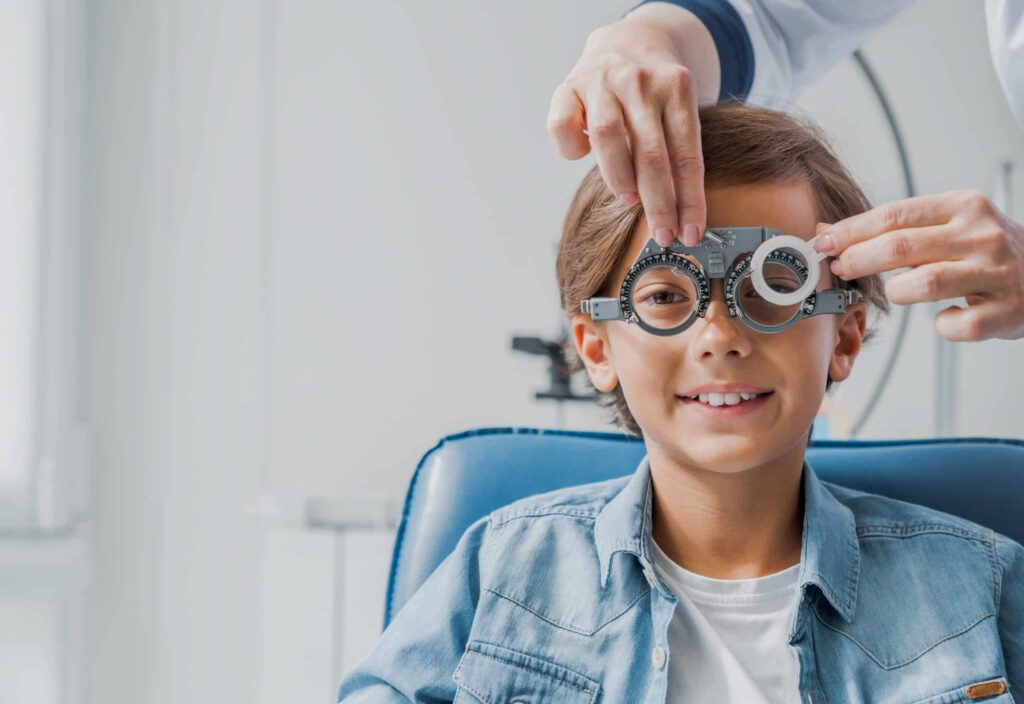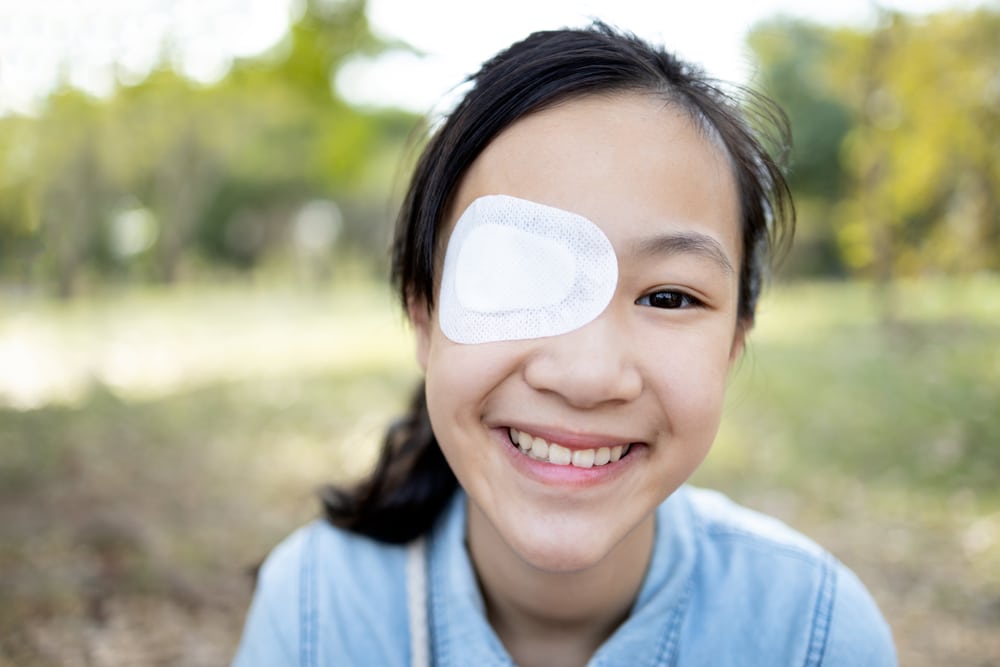Pediatric Ophthalmology and Eye Care

Eyecare should always be a priority at any age. At MidWest Eye Center, you’ll find our team of doctors are here for your family. Our pediatric eye doctors are well-versed in diagnosing and treating eye conditions in children.
Pediatric Vision Screening
Has your child been struggling to see the board at school? Do they squint or rub their eyes to try to improve their vision?
These may be some signs that your child is trying to tell you something is wrong with their vision. Pediatric vision screenings are crucial to ensuring your child can see the world around them.
To keep your child’s eyes healthy, start by bringing them in for vision screenings as early as their first newborn visit. Many common eye conditions can be diagnosed and treated early when your child regularly sees an ophthalmologist at MidWest Eye Center.
Children who do not have these conditions treated may result in worsening vision as they age. It can also affect their development.
Why Does My Child Need Routine Eye Exams?
Routine eye exams are necessary for all ages of life. A vision screening given at your child’s school or by your pediatrician can be helpful, but they are not something you should rely on.
Many vision screenings are unable to detect certain visual issues. For the most accurate results, bring your child to a pediatric ophthalmologist who can perform a routine eye exam.
During an eye exam, an ophthalmologist can check your child for common eye conditions like refractive errors, amblyopia, and strabismus. If they detect any of these eye conditions, they can help manage and treat your child, helping them improve their view of the world around them.
Dr. Maryam Ahmed-Naqvi discusses the importance of regular eye checkups, especially when students return back to school.
What Does a Pediatric Eye Exam Entail?

During a pediatric eye exam, your child will have their eyes checked for common eye conditions, including:
- Strabismus, or misaligned eyes
- Amblyopia (commonly called a lazy eye)
- Refractive errors (nearsightedness, farsightedness, or astigmatism)
During the eye exam, your child may have their eyes dilated to give us a better look at the inside of their eye from all angles. With dilation, expect your child’s eye exam to take about 1-2 hours to complete.
If your child is diagnosed with an eye condition, the next step will be to schedule follow-up appointments to determine treating the condition.
What are Refractive Errors?
Refractive errors are some of the most common eye conditions that children (and adults) can have. They include nearsightedness, farsightedness, and astigmatism.
A refractive error occurs when the shape of the eye prevents light from focusing directly on the back of the eye. When this happens, vision is blurry or impaired.
Nearsightedness
Nearsightedness occurs when the eye is longer than it should be, or the cornea is curved too steeply. Instead of the light being able to focus precisely on the retina, it focuses on the front.
The result is blurry vision when you look at things far away. Nearsightedness is usually diagnosed during childhood.
Farsightedness
Farsightedness is a refractive error that occurs when the cornea does not refract light as it should, leading to the point of focus falling behind the retina. When you’re farsighted, you’ll see things right in front of you as blurry or out of focus.
Farsightedness is often diagnosed in children and may lessen as they get older.
Astigmatism
Astigmatism occurs when the cornea is an irregular shape. The cornea is usually round, like a basketball. But if you have astigmatism, it will be like the shape of a football, resulting in distorted or blurry vision at all distances.
Treating Refractive Errors
The most common way to treat refractive errors in children is with visual aids. These include glasses and contact lenses.
In adulthood, you can permanently correct refractive errors with laser vision correction procedures like LASIK for those that qualify.
What is Amblyopia?
Amblyopia is the leading cause of vision loss in children. It leads to decreased vision in one or both eyes when vision does not develop appropriately during infancy or childhood.
Vision loss occurs because the nerves that connect the brain to the eyes cannot develop as they should. With amblyopia, the weaker eye cannot see in 20/20, causing the eye to favor the stronger eye.
Amblyopia has several causes, including cataracts, strabismus, and astigmatism. Treating amblyopia may involve wearing glasses to help the brain receive a clear image from both eyes and fully develop its vision. Children may also need to use eye drops or wear an eye patch to help the weaker eye become stronger.

What is Strabismus?
MidWest Eye Center handles eyecare for each stage of life. Watch Dr. Maryam Ahmed-Naqvi share her experience working with a young strabismus patient to achieve improved vision.
Strabismus is a condition that causes the eyes to misalign, meaning the eyes can’t look in the same direction simultaneously. Having strabismus may also be called “cross-eyed” or having a “lazy eye.”
You can have strabismus in one or both eyes, and it can affect children as well as adults. Their eyes’ movement describes the kind of strabismus a patient has.
These include crossing:
- Deviating outward
- Inward
- Moving up or down
If left untreated, strabismus can cause problems with your vision and vision loss. You may also start experiencing double vision or a shadow image.
Patients may notice issues with balance, difficulty with depth perception, and struggling to read and track. Treating strabismus in children may include eye patches, glasses, or eye muscle surgery.
What is Conjunctivitis?
Conjunctivitis (commonly called pink eye) is a prevalent eye infection among children. Those with conjunctivitis have inflammation of the conjunctiva, which is the white part of the eye. Many things can cause pink eye, like:
- Allergies
- Experiencing a chemical exposure
- Bacterial infection
Those with conjunctivitis may experience symptoms like red eyes, swollen eyelids, burning, or a yellowish/green discharge from the eyes. Treatments may vary depending on the kind of conjunctivitis your child has.
These can include artificial tears, cool compresses, and antihistamine eye drops. Conjunctivitis in most forms is highly contagious. See a pediatric ophthalmologist if you suspect your child has the infection.
Blocked Tear Ducts
Blocked tear ducts in children usually occur at or near birth due to a tube in the nose failing to open. A tear duct obstruction results in tears being unable to drain from the eyes.
Children with blocked tear ducts will experience crusting and discharge from the eye, which is most apparent after waking up. Children with blocked tear ducts may have red or swollen eyelids that are stuck together.
They may also have a green or yellow discharge from the eyes due to bacteria from the eyelids not flushing out. Many children with a tear duct obstruction see symptoms improve without treatment around 12 months old.
If a child has a more persistent obstruction, treatment options are available. These include topical antibiotic drops, ointments to the affected area, or tear duct massage.
If the blocked tear duct has not improved once the child is a year old, they’ll undergo tear duct surgery. The procedure involves using a probe that passes through the tear duct and opens the blocked membrane.
This may also include a balloon stent or tube with anesthesia to improve the procedure’s outcomes.
Congenital Ptosis
Congenital ptosis most commonly occurs when there is poor development in the muscle that elevates the eyelid in a child. Congenital ptosis is often present at birth and may affect one or both eyes.
It may not require treatment if the effects are mild and don’t affect visual development. If treatment is necessary, the child will undergo eyelid surgery if there are signs of delaying visual development. Children with ptosis should be monitored for other visual irregularities.
What are Pediatric Cataracts?
Although cataracts are usually associated with old age, they are also something you can be born with or develop at a young age. These can develop in one or both eyes.
Not all pediatric cataracts require treatment. Treatment is only necessary if cataracts interfere with the ability to see. Pediatric cataracts may occur due to metabolic or genetic disorders, certain medication use, or trauma to the face or head.
If a pediatric cataract is larger and affects a child’s ability to see, a surgeon will remove it with surgery. Children may wear special glasses or contacts after the procedure to see clearly.
Do you need to schedule an eye exam for your child? Request one at MidWest Eye Center at one of our convenient locations in the Tri-State area, including Cincinnati, OH, today!


